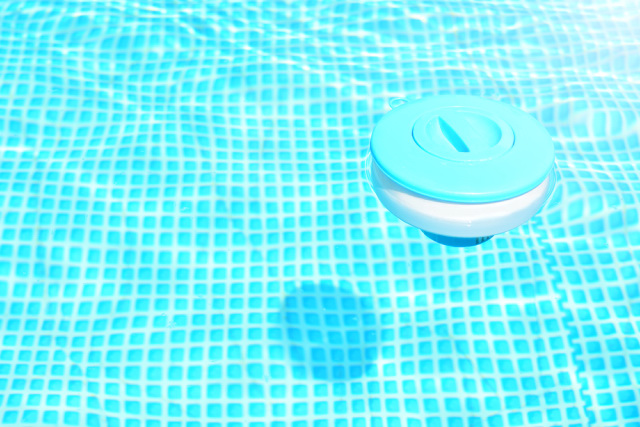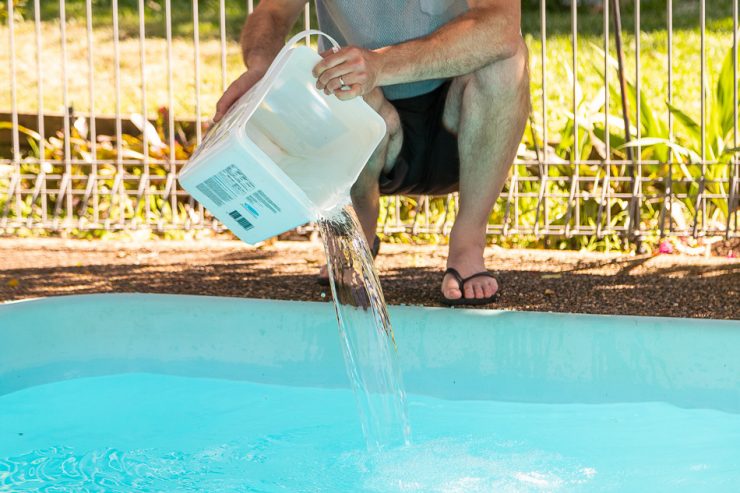So, you have a pool and you’re wondering: can you put chlorine granules or tablets into the pump basket? In this guide, we will go over the basics of chlorine granules and tablets, and if you should add them to your pump basket.
Never add chlorine granules or powder, chlorine tablets like dichlor, trichlor, or liquid chlorine to a pool pump basket. Chlorine is a strong and often acidic chemical that will the seals and plastic components in your pool pump as well as other pool equipment like pool filters.
There’s the short answer. You may be interested in why you shouldn’t add chlorine to the pump. Or the easiest ways to add chlorine to your pool. Read on to find out more.

Article Contents
Why Would You Want to Add Chlorine to Your Pump Basket?
Some pool owners have had the idea that adding chlorine to a pump basket is a good idea. Whether in tablet, granular, or liquid form, they see it as a way to:
- Dissolve the chlorine faster
- Get it dispersed faster
And doing that may mean a more efficient way to spread chlorine throughout the pool and kill algae and harmful bacteria.
Many people simply don’t have the time to learn the different ways of adding chlorine to a pool and want to take a shortcut to get their pool ready to swim in, thus they will add chlorine directly to the pump’s basket or even the skimmer and call it a day.
Unfortunately, there are no shortcuts in life, and adding chlorine to your pump’s basket or the skimmer may not be the best method of cleaning your pool.
Can I Put Chlorine in the Pump Basket?
Is it OK to add chlorine tablets or granules to the pool pump basket?
Chlorine in any form should never be added to your pool’s pump basket as it will damage the pump and reduce the life of other pool components. Many pool owners probably are unaware of the dangers of doing this, but we’ll do our best to explain why this should be avoided.
You also shouldn’t add chlorine to your skimmer. Here’s why: Should You Add Pool Chemicals to the Skimmer?
Why You Shouldn’t Add Chlorine to the Pump Basket
When it comes to keeping your pool clean and healthy, the pump is a necessary component. Your pump contains a plastic filter basket inside that catches any debris that makes it paste the skimmer basket.
In addition to this, your pump contains many rubber seals and delicate components.
Although you’d be right in thinking that the chlorine will dissolve faster and may disperse quicker.
However, when the pump is switched off, the chlorine will continue to dissolve. And this turns the water inside the pump into acidic water. Acidic water will shorten the life of the pump’s basket, making it brittle. Not only this, it will damage the delicate seals inside the pump.
Adding chlorine to the pump causes these issues:
- Brittle pump basket/strainer
- Deteriorates pump seals
- Can damage pool filters (especially cartridge filters)
- Can damage pool heaters.
When the pump is turned back on, this acidic water, which is still in your pump, shoots straight into the filter and pool heater (if you have one).
This highly concentrated chlorine can cause irreversible damage to many components such as the pump itself, the filter, and the pool’s heater and you will have to replace them which can be quite costly.
Can You Put Pool Shock in the Pump Basket or Skimmer?
Since pool shock is just a strong form of chlorine, you should not add it to your pump basket as it can cause damage to your pump’s internal components and pool filter.
Chlorine is a harsh chemical and needs to be diluted and either added directly into the pool’s water or added via a chlorinator (chlorine feeder) or chlorine floater.
How Do You Add Chlorine Tablets to Your Pool?
1. Use a Chlorinator (Chlorine Feeder)
Instead of adding chlorine to your pump’s basket or skimmer, we suggest purchasing a chlorinator (chlorine feeder). This device is automatic and you can adjust the settings to when and how much chlorine is added to your pool.
Chlorinators are great to use with your pump and filter and are pretty easy to get going.
2. Use a Chlorine Floater
If you’re limited on time and don’t wish to install a chlorinator in your pool system, you can alternatively purchase a floating chlorinator. With this floating device, all you do is add a chlorine tablet and allow the plastic unit to float around in your pool to let it dissipate on its own.
If you’re still having trouble deciding between an automatic chlorinator and a floating chlorinator, let’s look go over some basics for each device.
Floating Chlorinator
The floating chlorinator, as mentioned previously, is a device where you simply add a tablet, put a lid on top, and then add it to your pool. It will float around on its own and allow the tablet to dissipate, slowly adding the chemical in.
Perhaps you’re wondering how many tablets you need? Check out this article: How Many Chlorine Tablets Do You Need in Pool or Floater?
The floating chlorinator is cheaper than the automatic one and won’t break the bank. In fact, it usually costs less than $20 to buy one.
However, keep in mind that you may need to closely monitor this device as it can get trapped behind ladders and in corners of your pool and will not distribute the chlorine evenly throughout.
Another disadvantage to the floating chlorinator is that it can end up bleaching the walls of your pool, so it’s not recommended if you have a vinyl-lined pool.
Pros:
- Budget-friendly
- No installation required
- Easy to use
- Distribution of chlorine is good
Cons:
- Can get trapped easily
- Causes damage to pool walls if it gets stuck in a corner (should be avoided if the pool is vinyl-lined)
- Made of cheap plastic which can be damaged from UV rays and eventually break
- Is not to be used with granules or liquid chlorine

Automatic Chlorinator (Chlorine Feeder)
The automatic chlorinator will take a little more elbow grease to use as it needs to be installed in the filter system of your pool’s pump. However, once installed, this unit is one of the best methods of keeping your pool water clean and free from contaminates.
The way it works is similar to the floating device: add tablets or liquid to the chlorinator and it will be released slowly throughout the pool by the return jets.
However, keep in mind that as there are multiple types of chlorine, you will need to pick one type of chlorine. Do not mix chlorine types.
Pros:
- Easy to use
- Can hold several tablets
- Can be timed to release chlorine
- Better built and will last longer
Cons:
- Costlier
- Has to be installed
- Does not support granular chlorine
How Do You Add Chlorine Granules to Your Pool?
Adding granular chlorine to your pool is a little more time-consuming.
The short version is that you need to measure the granular chlorine, pour it into a plastic bucket (preferably a 5 gallon (19 L) one), and then add it around the perimeter of your pool.
However, let’s go into a little more depth here.
Test the Water
Before you add the granular chlorine to your pool or even begin to mix it, make sure you test your water first to see how much chlorine is already in the water. You will have to determine how much chlorine needs to be added to your pool on your own.
Add Chlorine to a Bucket of Pool Water
Once you have the results recorded, place the bucket into the pool and add some water from the pool into the bucket. The recommended amount is about 3/4ths of the bucket.
Afterward, you will want to gradually add the chlorine you had measured out in the first step to the water in the bucket and stir the contents until the powder has dissolved.
Pour in Pool
Lastly, you will want to add the solution to your pool. This should also be done slowly and gradually.
Never add this mixture to the pool basket or skimmer. This can cause irreversible damage to your pool’s pump and will cost you more down the road.
Please keep in mind that since you are working with harsh chemicals, it is recommended to wear gloves and glasses for your safety and protection.

How Do You Add Liquid Chlorine to Your Pool?
Similar to granular chlorine, you will not want to add liquid chlorine to your pool’s pump basket. You can either add it directly into your pool with the pool filter running or you can put the liquid chlorine in your automatic chlorinator but keep in mind that it should not be added to a floating one.
The great thing about liquid chlorine is that it doesn’t require any premixing, it can be added straight to the pool. Just pour it in.
Final Thoughts
So, can you put chlorine granules or tablets into the pump basket? Well, you know by now not to put chlorine tablets, granules or even liquid chlorine in the pump basket.
In this guide, we went into depth regarding why chlorine cannot be added to the pump’s basket or skimmer and how to safely and effectively add chlorine tablets, chlorine granules, and liquid chlorine to your pool.
You should now have a good understanding of how to best maintain and care for your pool when it comes to adding chlorine – a beneficial part of pool maintenance that will help to keep your pool’s water safe and healthy so that you, your family, and your friends can enjoy a nice swim.


